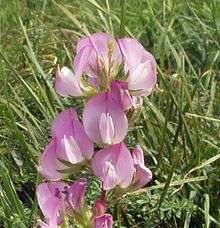Ononis spinosa
Ononis spinosa is a plant belonging to the family Fabaceae, that is commonly known as spiny restharrow or just restharrow. It is found throughout much of Europe including Britain, but seldom as far north as Scotland.
| Ononis spinosa | |
|---|---|
 | |
| Scientific classification | |
| Kingdom: | Plantae |
| Clade: | Tracheophytes |
| Clade: | Angiosperms |
| Clade: | Eudicots |
| Clade: | Rosids |
| Order: | Fabales |
| Family: | Fabaceae |
| Genus: | Ononis |
| Species: | O. spinosa |
| Binomial name | |
| Ononis spinosa | |
| Synonyms | |
|
Ononis vulgaris Rouy pro parte | |
Description
Spiny restharrow is an erect, bushy perennial. The wiry, branched stem is downy and nearly always spiny, and grows to a height of 18 in (46 cm). The leaves are small, dark green, oval or trefoil, with toothed leaf-like stipules at their base. The flowers are deep pink and white, with the wings shorter than the hooked keel, and the calyx usually shorter than the pod.[1]
Distribution and habitat
Spiny restharrow is found in southern temperate areas of Europe and Siberia. In the British Isles it occurs predominantly in central and southeastern England. Its typical habitat is lime-rich but nutrient-poor grassland on chalk and heavy, calcareous soils.[2] It grows in the Plaster's Green Meadows, an SSSI in Lincolnshire.[3]
Historical use
In medieval Russia, it used to be used for manufacturing Bulat steel. Though the original process is now lost, it is known it involved dipping the finished weapon into a vat containing a special liquid of which spiny restharrow extract was a part (the plant's name in Russian, stalnik, reflects its historical role), then holding the sword aloft while galloping on a horse, allowing it to dry and harden against the wind.[4]
In traditional Russian herbal medicine, it is used as an anodyne, antiphlogistic, aperient, coagulant and diuretic. It is considered helpful in treating urinary catarrh, kidney inflammation, and rheumatism, as well as aiding those who accumulate uric acid and are susceptible to kidney stones. A decoction of restharrow is used to treat eczema and other skin problems. It is used over an average course of six weeks to treat hemorrhoids, chronic constipation and infections of the anus.[4]
References
- McClintock, David; Fitter, R.S.R. (1961). The Pocket Guide to Wild Flowers. London: Collins. p. 58.
- "Ononis spinosa". Online Atlas of the British and Irish Flora. Retrieved 16 March 2020.
- "Plaster's Green Meadows citation" (PDF). Sites of Special Scientific Interest. Natural England. Retrieved 16 March 2020.
- Zevin, Igor Vilevich. A Russian Herbal. 1997. Rochester, Vermont: Healing Arts Press. p.122.
External links
